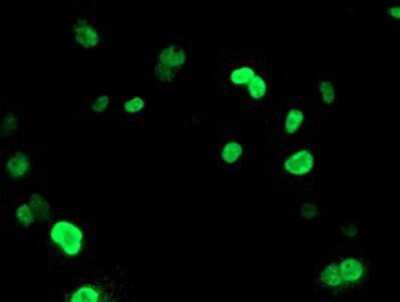UNG Antibody (OTI1A11)
Novus Biologicals, part of Bio-Techne | Catalog # NBP2-01194

![Western Blot: UNG Antibody (OTI1A11) [NBP2-01194] Western Blot: UNG Antibody (OTI1A11) [NBP2-01194]](https://resources.bio-techne.com/images/products/uracil-DNA-glycosylase-Antibody-1A11-Western-Blot-NBP2-01194-img0001.jpg)
Conjugate
Catalog #
Forumulation
Catalog #
Key Product Details
Species Reactivity
Human, Mouse, Rat
Applications
Immunocytochemistry/ Immunofluorescence, Immunohistochemistry, Immunohistochemistry-Paraffin, Western Blot
Label
Unconjugated
Antibody Source
Monoclonal Mouse IgG1 Clone # OTI1A11
Concentration
0.79 mg/ml
Product Specifications
Immunogen
Full length human recombinant protein of human UNG(NP_550433) produced in HEK293T cell.
Reactivity Notes
Please note that this antibody is reactive to Mouse and derived from the same host, Mouse. Mouse-On-Mouse blocking reagent may be needed for IHC and ICC experiments to reduce high background signal. You can find these reagents under catalog numbers PK-2200-NB and MP-2400-NB. Please contact Technical Support if you have any questions.
Clonality
Monoclonal
Host
Mouse
Isotype
IgG1
Theoretical MW
34.5 kDa.
Disclaimer note: The observed molecular weight of the protein may vary from the listed predicted molecular weight due to post translational modifications, post translation cleavages, relative charges, and other experimental factors.
Disclaimer note: The observed molecular weight of the protein may vary from the listed predicted molecular weight due to post translational modifications, post translation cleavages, relative charges, and other experimental factors.
Scientific Data Images for UNG Antibody (OTI1A11)
Western Blot: UNG Antibody (OTI1A11) [NBP2-01194]
Western Blot: uracil-DNA glycosylase Antibody (1A11) [NBP2-01194] - HEK293T cells were transfected with the pCMV6-ENTRY control (Left lane) or pCMV6-ENTRY uracil-DNA glycosylase (Right lane) cDNA for 48 hrs and lysed. Equivalent amounts of cell lysates (5 ug per lane) were separated by SDS-PAGE and immunoblotted with anti-uracil-DNA glycosylase.
Immunocytochemistry/Immunofluorescence: uracil-DNA glycosylase Antibody (1A11) [NBP2-01194] Staining of COS7 cells transiently transfected by pCMV6-ENTRY uracil-DNA glycosylase.
Immunohistochemistry-Paraffin: UNG Antibody (OTI1A11) [NBP2-01194]
Immunohistochemistry-Paraffin: uracil-DNA glycosylase Antibody (1A11) [NBP2-01194] - Staining of paraffin-embedded Human tonsil using anti-uracil-DNA glycosylase mouse monoclonal antibody.Applications for UNG Antibody (OTI1A11)
Application
Recommended Usage
Immunocytochemistry/ Immunofluorescence
1:100
Immunohistochemistry
1:150
Immunohistochemistry-Paraffin
1:150
Western Blot
1:2000
Formulation, Preparation, and Storage
Purification
Immunogen affinity purified
Formulation
PBS (pH 7.3), 1.0% BSA and 50% Glycerol
Preservative
0.02% Sodium Azide
Concentration
0.79 mg/ml
Shipping
The product is shipped with polar packs. Upon receipt, store it immediately at the temperature recommended below.
Stability & Storage
Store at -20C. Avoid freeze-thaw cycles.
Background: UNG
Long Name
Uracil N-Glycosylase
Alternate Names
DGU, UDG
Entrez Gene IDs
7374 (Human)
Gene Symbol
UNG
Additional UNG Products
Product Documents for UNG Antibody (OTI1A11)
Product Specific Notices for UNG Antibody (OTI1A11)
This product is for research use only and is not approved for use in humans or in clinical diagnosis. Primary Antibodies are guaranteed for 1 year from date of receipt.
Loading...
Loading...
Loading...
Loading...

![Immunohistochemistry-Paraffin: UNG Antibody (OTI1A11) [NBP2-01194] Immunohistochemistry-Paraffin: UNG Antibody (OTI1A11) [NBP2-01194]](https://resources.bio-techne.com/images/products/uracil-DNA-glycosylase-Antibody-1A11-Immunohistochemistry-Paraffin-NBP2-01194-img0006.jpg)
![Immunohistochemistry-Paraffin: UNG Antibody (OTI1A11) [NBP2-01194] Immunohistochemistry-Paraffin: UNG Antibody (OTI1A11) [NBP2-01194]](https://resources.bio-techne.com/images/products/uracil-DNA-glycosylase-Antibody-1A11-Immunohistochemistry-Paraffin-NBP2-01194-img0002.jpg)
![Immunohistochemistry-Paraffin: UNG Antibody (OTI1A11) [NBP2-01194] Immunohistochemistry-Paraffin: UNG Antibody (OTI1A11) [NBP2-01194]](https://resources.bio-techne.com/images/products/uracil-DNA-glycosylase-Antibody-1A11-Immunohistochemistry-Paraffin-NBP2-01194-img0003.jpg)
![Immunohistochemistry-Paraffin: UNG Antibody (OTI1A11) [NBP2-01194] Immunohistochemistry-Paraffin: UNG Antibody (OTI1A11) [NBP2-01194]](https://resources.bio-techne.com/images/products/uracil-DNA-glycosylase-Antibody-1A11-Immunohistochemistry-Paraffin-NBP2-01194-img0004.jpg)
![Immunohistochemistry-Paraffin: UNG Antibody (OTI1A11) [NBP2-01194] Immunohistochemistry-Paraffin: UNG Antibody (OTI1A11) [NBP2-01194]](https://resources.bio-techne.com/images/products/uracil-DNA-glycosylase-Antibody-1A11-Immunohistochemistry-Paraffin-NBP2-01194-img0005.jpg)